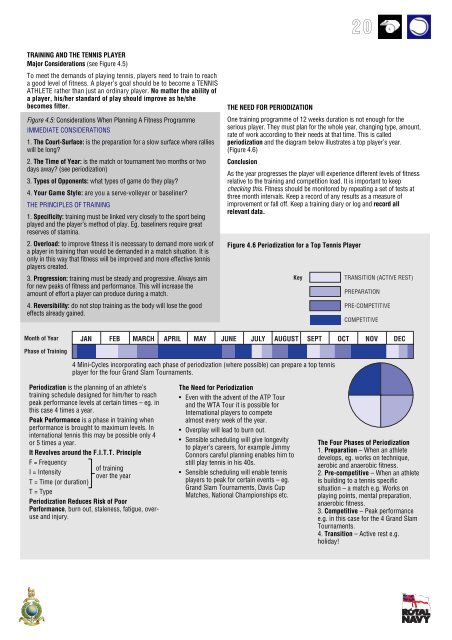Tennis Book for PDF - Gloucester Academy
Tennis Book for PDF - Gloucester Academy
Tennis Book for PDF - Gloucester Academy
You also want an ePaper? Increase the reach of your titles
YUMPU automatically turns print PDFs into web optimized ePapers that Google loves.
TRAINING AND THE TENNIS PLAYER<br />
Major Considerations (see Figure 4.5)<br />
To meet the demands of playing tennis, players need to train to reach<br />
a good level of fitness. A player’s goal should be to become a TENNIS<br />
ATHLETE rather than just an ordinary player. No matter the ability of<br />
a player, his/her standard of play should improve as he/she<br />
becomes fitter.<br />
Figure 4.5: Considerations When Planning A Fitness Programme<br />
IMMEDIATE CONSIDERATIONS<br />
1. The Court-Surface: is the preparation <strong>for</strong> a slow surface where rallies<br />
will be long?<br />
2. The Time of Year: is the match or tournament two months or two<br />
days away? (see periodization)<br />
3. Types of Opponents: what types of game do they play?<br />
4. Your Game Style: are you a serve-volleyer or baseliner?<br />
THE PRINCIPLES OF TRAINING<br />
1. Specificity: training must be linked very closely to the sport being<br />
played and the player’s method of play. Eg. baseliners require great<br />
reserves of stamina.<br />
2. Overload: to improve fitness it is necessary to demand more work of<br />
a player in training than would be demanded in a match situation. It is<br />
only in this way that fitness will be improved and more effective tennis<br />
players created.<br />
3. Progression: training must be steady and progressive. Always aim<br />
<strong>for</strong> new peaks of fitness and per<strong>for</strong>mance. This will increase the<br />
amount of ef<strong>for</strong>t a player can produce during a match.<br />
4. Reversibility: do not stop training as the body will lose the good<br />
effects already gained.<br />
Month of Year<br />
Phase of Training<br />
20<br />
THE NEED FOR PERIODIZATION<br />
One training programme of 12 weeks duration is not enough <strong>for</strong> the<br />
serious player. They must plan <strong>for</strong> the whole year, changing type, amount,<br />
rate of work according to their needs at that time. This is called<br />
periodization and the diagram below illustrates a top player’s year.<br />
(Figure 4.6)<br />
Conclusion<br />
As the year progresses the player will experience different levels of fitness<br />
relative to the training and competition load. It is important to keep<br />
checking this. Fitness should be monitored by repeating a set of tests at<br />
three month intervals. Keep a record of any results as a measure of<br />
improvement or fall off. Keep a training diary or log and record all<br />
relevant data.<br />
Figure 4.6 Periodization <strong>for</strong> a Top <strong>Tennis</strong> Player<br />
Key TRANSITION (ACTIVE REST)<br />
PREPARATION<br />
PRE-COMPETITIVE<br />
COMPETITIVE<br />
JAN FEB MARCH APRIL MAY JUNE JULY AUGUST SEPT OCT NOV DEC<br />
4 Mini-Cycles incorporating each phase of periodization (where possible) can prepare a top tennis<br />
player <strong>for</strong> the four Grand Slam Tournaments.<br />
Periodization is the planning of an athlete’s<br />
training schedule designed <strong>for</strong> him/her to reach<br />
peak per<strong>for</strong>mance levels at certain times – eg. in<br />
this case 4 times a year.<br />
Peak Per<strong>for</strong>mance is a phase in training when<br />
per<strong>for</strong>mance is brought to maximum levels. In<br />
international tennis this may be possible only 4<br />
or 5 times a year.<br />
It Revolves around the F.I.T.T. Principle<br />
F = Frequency<br />
I = Intensity<br />
T = Time (or duration)<br />
T = Type<br />
of training<br />
over the year<br />
Periodization Reduces Risk of Poor<br />
Per<strong>for</strong>mance, burn out, staleness, fatigue, overuse<br />
and injury.<br />
The Need <strong>for</strong> Periodization<br />
• Even with the advent of the ATP Tour<br />
and the WTA Tour it is possible <strong>for</strong><br />
International players to compete<br />
almost every week of the year.<br />
• Overplay will lead to burn out.<br />
• Sensible scheduling will give longevity<br />
to player’s careers, <strong>for</strong> example Jimmy<br />
Connors careful planning enables him to<br />
still play tennis in his 40s.<br />
• Sensible scheduling will enable tennis<br />
players to peak <strong>for</strong> certain events – eg.<br />
Grand Slam Tournaments, Davis Cup<br />
Matches, National Championships etc.<br />
The Four Phases of Periodization<br />
1. Preparation – When an athlete<br />
develops, eg. works on technique,<br />
aerobic and anaerobic fitness.<br />
2. Pre-competitive – When an athlete<br />
is building to a tennis specific<br />
situation – a match e.g. Works on<br />
playing points, mental preparation,<br />
anaerobic fitness.<br />
3. Competitive – Peak per<strong>for</strong>mance<br />
e.g. in this case <strong>for</strong> the 4 Grand Slam<br />
Tournaments.<br />
4. Transition – Active rest e.g.<br />
holiday!



